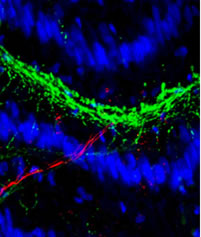Electrical Activity Alters Language Used By Nerve Cells
December 19, 2006
By Sherry Seethaler

Image showing junction (green) between nerve (red) and muscle cells (blue) Credit: Laura N. Borodinsky, UCSD
UC San Diego biologists have shown that the chemical language with which neurons communicate depends on the pattern of electrical activity in the developing nervous system. The findings suggest that modification of nerve activity could have potential as a treatment for a wide range of brain disorders.
In the study, published this week in the early on-line edition of the journal Proceedings of the National Academy of Sciences, the biologists showed that, contrary to the prevailing viewpoint, neurotransmitters-the chemical language of nerve cells-and receptors-the proteins that receive and respond to neurotransmitters-are not specified by a rigid genetic program. Altering nerve activity during development determines the "mother tongue" nerve cells use to communicate. The study will appear in the print edition of PNAS on January 2.
"Most cognitive disorders, such as depression, schizophrenia and Parkinson's disease, involve problems with neurotransmitters or neurotransmitter receptors," said Nicholas Spitzer, a professor of biology and the senior author of the study. "If modifying electrical activity in the adult brain can alter neurotransmitters and receptors similarly to the way we have discovered in the developing frog nervous system, it could provide a promising approach to treating these disorders."
In vertebrates including frogs and humans, nerves communicate with muscles by releasing a neurotransmitter called acetylcholine. Spitzer and Laura Borodinsky, who was an assistant project scientist working with Spitzer when she performed the research, wanted to know if genetics is the only factor responsible for the selection of acetylcholine as the language used in nerve to muscle communication, or if other factors could play a role.
To find out, the researchers used drugs to increase and decrease the electrical activity in nerve cells of frog embryos. These changes in activity changed the identity of the neurotransmitter produced by the nerve cells. Because the new chemical language being used by the nerves would not be detected if the muscles continued to produce only acetylcholine receptors, Spitzer and Borodinsky also looked for changes in the muscle cells' transmitter receptors.
They discovered that, unlike in adult muscle, very early in development the muscle cells actually make multiple types of receptors, not just acetylcholine receptors. Remarkably, neurotransmitter receptors on the muscle cells are selected to match the neurotransmitter being produced by the nerve cells when early activity is perturbed.
"Our discovery, that developing muscle cells express several different types of neurotransmitter receptors, is surprising," said Borodinsky, who is now an assistant professor of physiology at the U.C. Davis School of Medicine. "The vertebrate neuromuscular junction has been very well studied, and it has long been thought that acetylcholine was the only neurotransmitter used there.
"Sometimes people studying development can be misled by knowing how things work in an adult animal," she added. "You have so much information about the end point that you may not open your eyes to what happens early on."
The results show that the development of communication between nerves and muscles is flexible. Rather than a genetic program specifying that acetylcholine will be the language of communication, it is one of several languages that nerve cells are capable of using. Similarly, muscle cells have the potential to understand several languages. During development, the level of electrical activity in nerve cells determines which of many possible neurotransmitter languages will be used.
"It may seem wasteful to start with multiple types of receptors, and then eliminate the ones that aren't needed," commented Spitzer. "But it provides organisms with the ability to adapt to the environmental conditions in which they are living."
The researchers are not certain if the adult human brain will retain this same flexibility, but experimental treatments involving electrical stimulation of the brain are being used by other researchers in clinical practice. Spitzer thinks this study provides useful information for the researchers developing these therapies.
"Our research provides new insight about a way in which electrical stimulation affects communication in the nervous system," explained Spitzer. "If electrical stimulation shows promise as a treatment, understanding the mechanism by which it works should make it possible to be much more selective about how and where to stimulate the brain."
The study was supported by the National Institutes of Health and the National Science Foundation.
Media Contact: Sherry Seethaler, (858) 534-4656
Comment: Nicholas Spitzer, (858) 534-3896
